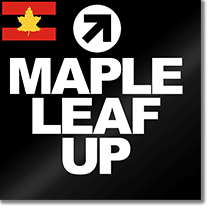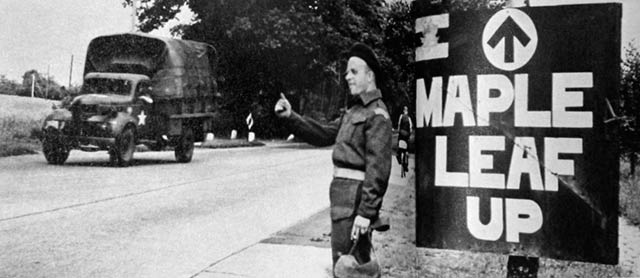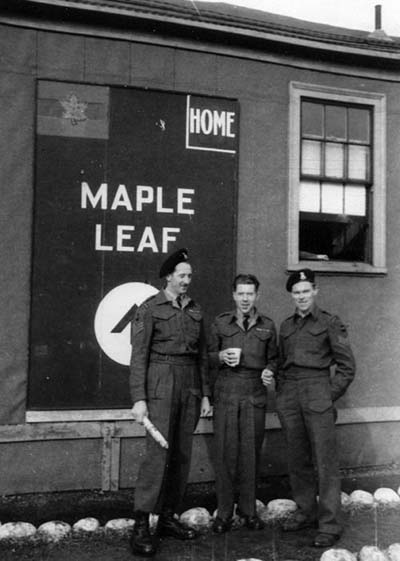What Is Maple Leaf Up?
Well for our purposes, "Maple Leaf Up" has two meanings...
First meaning |
Second meaning |
|
The original expression is taken directly from WW2 road signs in Northwest Europe, marking out the Maple Leaf Route, the supply line of the 1st Canadian Army. To move towards the front lines was coined "Maple Leaf Up". Read below... |
We are extending the original road sign expression into a sentiment, using "Maple Leaf" to embody several things Canadian, and "Up" in terms of promoting or advancing things Canadian. For more continue to next page... |
|
*****
 The term MAPLE LEAF UP was posted on road signs staked along the fractured highways that pointed the way to the ever-shifting Canadian front lines in the ground battles for Northwest Europe. These routes were crucial logistical arteries extending from the Normandy beaches deep into Belgium, the Netherlands, and eventually Germany itself. Scores of supply trucks carried their essential cargos — food, ammunition, fuel, weapons, reinforcements — UP to feed the cutting edge of Canada’s first and only field army — First Canadian Army.
The term MAPLE LEAF UP was posted on road signs staked along the fractured highways that pointed the way to the ever-shifting Canadian front lines in the ground battles for Northwest Europe. These routes were crucial logistical arteries extending from the Normandy beaches deep into Belgium, the Netherlands, and eventually Germany itself. Scores of supply trucks carried their essential cargos — food, ammunition, fuel, weapons, reinforcements — UP to feed the cutting edge of Canada’s first and only field army — First Canadian Army.
Returning from that weary front, returning to the rear along that same route — in the direction now appropriately marked MAPLE LEAF DOWN — trucks and ambulances full of wounded gently coursed their way past pockmarks and shell holes, back to offload and re-supply with fresh rations, ammunition, soldiers. It was a cycle that would make them turn again and head UP to feed the unrelenting demands of a field army at war.
*****

This photograph is purportedly by CFPU photographer Fred Whitcombe, taken in Netherlands well after VE Day. The painted flag in the top left corner of the sign is the banner for First Canadian Army as can be seen in the coloured illustration above. (Unfortunately we cannot find the original in the Library & Archives Canada, so this is a scan from a book.)
In the introduction to his book “Maple Leaf Up — Maple Leaf Down”, author Captain Peter Simonds wrote:
The title, perhaps, requires a brief explanation. “Maple Leaf Up” was the name of the main route to First Canadian Army during the whole Western Europe operation. To get to the First Canadian Army, one followed the painted maple leaf or written words, MAPLE LEAF, plus the word UP; to get back to the rear areas, away from the army, one followed the maple leaf signs, plus the word DOWN. The tanks and vehicles loaded with supplies and reinforcements for the army rolled along MAPLE LEAF UP; the empty trucks and full ambulances rolled along MAPLE LEAF DOWN.
—Peter Simonds, Edmonton, May 1946
Peter Simonds happened to be the brother of Canadian 2nd Corps Commander Lt-General Guy Simonds.
*****

February 1945, entering Germany. Lance-Corporal R.B. Wrightman of the Canadian Provost Corps reads a sign which warns, "Don't Fraternize - Onyx Route Starts Here" in Calcar, Germany. First Canadian Army was the first of the Allied Armies into the Rhineland. The flag in the upper left of the bottom sign represents 2nd Canadian Corps. (Photographer: Ken Bell; Library and Archives Canada a145762)

July 1945, after the surrender of Germany. Vehicles and motorcycles of Les Fusiliers Mont-Royal moving "down" through Leer, Germany. The signs point "Maple Leaf Down", back to Groningen, the closest major city in the northern Netherlands and London, England. (Photographer: Dan Guravich; Library and Archives Canada a140101)

January 1946 — the ultimate "Maple Leaf Down" sign. Earl Tomalty, George Skinner, and Armand Connell of the Sherbrooke Fusilier Regiment have just disembarked in Halifax, Canada. (Photographer: Jim Jones; Maple Leaf Up collection)






